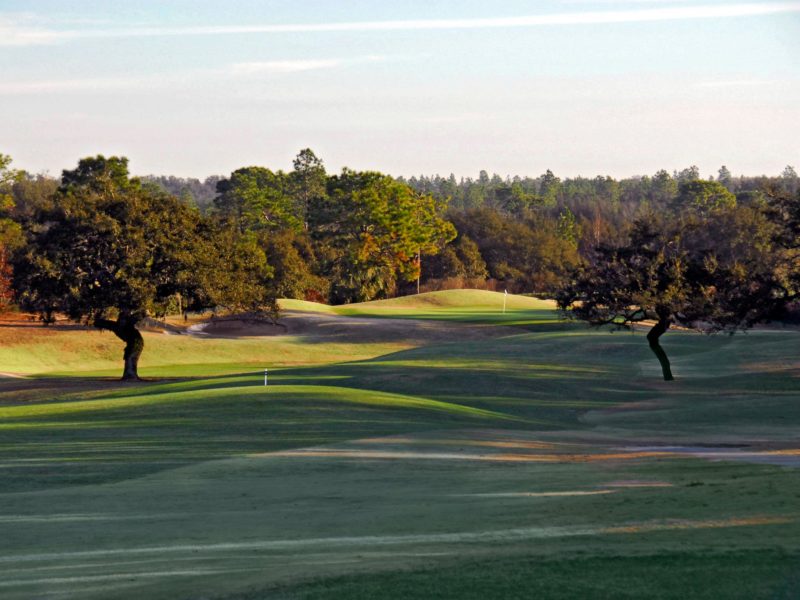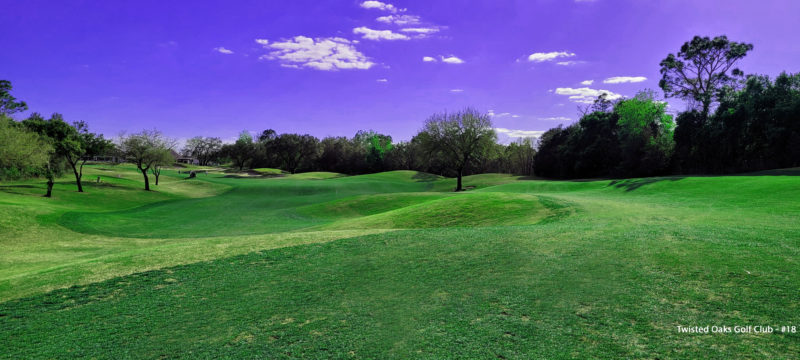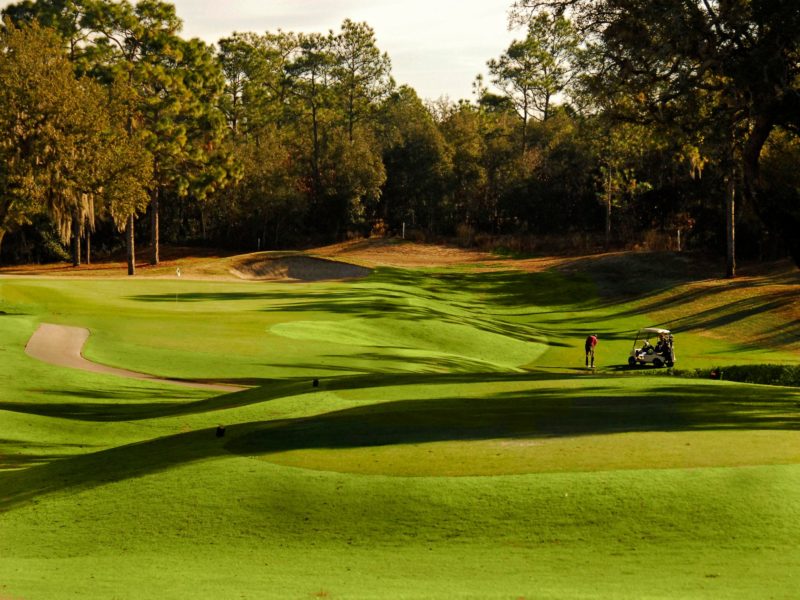Karl Litten-designed course is perfect for winter golfers looking for plenty of green grass
BEVERLY HILLS, Florida – Twisted Oaks Golf Club is not your typical Florida golf course. Like many courses in the Sunshine State, it offers rolling hills, well-groomed fairways and greens, several blind shots, and a lot of terrific views. Twisted Oaks will challenge golfers at every skill level and the staff can offer tips to help you play your best and enjoy your surroundings.
As you make your way around the course, you’ll notice a lot of mounding and undulation in the fairways and along the peripheries; something that separates Twisted Oaks from many other flat Florida courses. There’s a lot more to this track than your typical sand, water, and palm trees!
Several holes feature significant elevation changes – at least for Florida. The seventh hole requires an extra club to get to the elevated green on your approach shot. Golf Course superintendent Chuck Barclay always has the course in top condition and the greens putt true and tend to run a little bit on the quick side. There’s some good undulation to them, but they won’t leave you scratching your head.

The golf club offers yardages for just about every level of golfer. Ladies and seniors can choose to play from the forward tees at 4,649 yards, with a course rating of 66 and a slope of 115. Better golfers can step back to the black tees (6,880/73/130) and seriously challenge themselves. Others can choose the blue Tees (6,479/70.9/123), the white Tees (5,928/68.4/121) or the golds (5,241/64.6/112). Choose the tees that best match your game and you’re sure to have a good time.
Twisted Oaks starts with a very challenging par 5 that plays 514 yards from the white Tees and for the majority of players is going to be a three-shot hole. It’s a moderate double dogleg and you can’t see the green from the tee, which creates a blind tee shot. Once you reach the top of the hill for your second shot, you can see the rest of the hole, and all of the hills and mounding you see gives you a pretty good idea of what’s in store.
Play your layup shot right of the tree on the left to have the best angle into the green. Your approach shot is slightly uphill into a green that slopes back to front and is protected by two bunkers on the right side and a large bunker in the back. It’s a great starting hole.
The sixth hole is a short, 431-yard (white tees) par 5 that can be reached with two extraordinary shots. The last time I played the course, I told myself I was going to go over the trees, cut the corner and get home in two. Fortunately, my playing partners talked some sense into me.

First of all, you’ll either need to hit a drive over the trees and around the corner of the dogleg or over the trees left of the cart path and down the left side. A good drive will leave less than 225 yards to the pin. Over the trees will leave a clearer shot into the green. Should you choose the left, you’ll need to navigate over trees and a large bunker in front. No. 6 can yield some low scores, but it can also hand out some big numbers too.
The eighth hole is a picturesque par 3 that plays 152 yards (white tees) into a large green fronted by a beautifully rock-landscaped pond front left and sand on the right. There’s a lot of mounding if you’re long and can make for a tough recovery. Par is a good score here.
No. 10 may well be the one hole that helped name the golf course. It’s a 363-yard par 4 that at first glance looks fairly straightforward. The twisted oak trees sit on either side of the fairway in the landing area. They sit about 140 yards from the green and there’s not a lot of room between them. If you can’t get over them off the tee, the trick is to leave enough room between the ball and the trees to go over them. You’ll need to take enough club on your approach shot, anything short will trickle down the hill and leave a tough uphill approach shot. The green is protected by a large bunker left and is surrounded by grass mounds.
The 13th is another long and challenging par 5. It’s a 530-yard par-five dogleg left that keeps turning left and is going to be a three-shot hole. If you can hit a draw, now’s the time to do it. The bunkering in the landing area of your layup shot looks great and hopefully won’t come into play. Your approach shot plays slightly downhill, yet anything short will leave a difficult uphill chip shot into the green.
Looking for a risk/reward opportunity? No. 17 is a 336-yard par 4 dogleg right. If you’re a longball hitter and can hit a fade, this may be the chance you’ve been looking for. Alternatively, if you can place your drive between the two oak trees just left of the large fairway waste bunker, you’ll have a short slightly uphill tee shot and a chance at par or better.
The 18th hole is one of the best finishing holes in the area. It’s another dogleg left, and a good drive can leave a chance to get home in two. The hole plays 481 yards from the white tees with lots of mounding in the fairway. Hit a good drive down the middle and you’ll have a little more than 200 yards uphill into an elevated green. If you can’t get home in two, play your layup shot out to the right side for the best angle. Par or better is a great way to end your round.
Twisted Oaks is owned by PGA professional Tommy Lyman, who also serves as the general manager. Lyman knows what his golfers want, especially the ones that venture down from up north every winter: green grass. Because of this, Twisted Oaks is one of the few remaining courses that overseed their fairways, tee boxes, and greens every year to maintain that lush, green color.
Although it is appealing to the eye, it can be a golf course superintendent’s nightmare, but course superintendent Chuck Barclay and his staff are up to the challenge each year.
“We sometimes struggle in the spring with the transition from Ryegrass back to Bermuda, and a lot of that depends on what Mother Nature throws at us,” Barclay said. “Thankfully, the past few years we’ve gone into the fall overseed with really healthy Bermuda grass which helps a lot. These are the original greens from when the course was built in 1988 and quite honestly, with all the play they get, they wouldn’t have survived this long if we didn’t overseed.”
Something that should help boost play if not membership is the new 207-home Fairways at Twisted Oaks subdivision going in adjacent to the par 3 eighth hole. Eighty-nine new homes will be surrounded by five holes on the golf course off Forest Ridge Boulevard as the single-family deed-restricted community is built in three phases.
Lyman said that “the COVID-19 pandemic has prompted homeowners to move out of busy cities and seek rural tranquility in places like Citrus County and the Fairways at Twisted Oaks fits the bill.”
In addition to a challenging and well-conditioned golf course, Twisted Oaks also has some of the best practice facilities in the area; it’s not uncommon to see players out on the range working on their game. In addition to a full-length driving range with target greens, there’s also chipping and putting greens and fairway and greenside bunkers. You can work on every part of your game. Should you need help, Lyman is also the head golf professional and is available to help.
Although it’s a daily fee facility, Twisted Oaks offers annual memberships for singles, couples, and seasonal residents. Your membership includes unlimited greens and cart fees, 14-day advanced tee times and preferred tee times as well as participation in member club events and the Men’s/Ladies Golf Associations.


